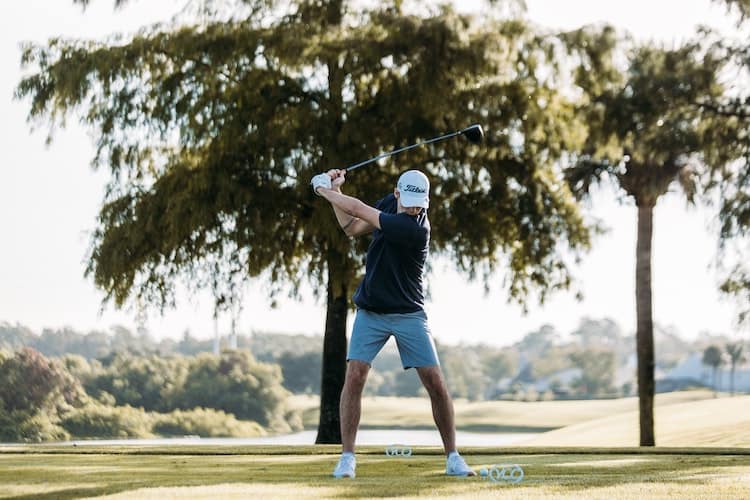
A golf swing is a complicated motion that requires synergy between your arms, shoulders, and lower body. Each element must perform optimally to deliver a rhythmic swing and maximum power.
In this post, I look at the role of your left arm in the procedure, specific to right-handed golfers. If you are left-handed, simply apply these lessons to your right arm. I will break down the positioning of your left arm during setup, takeaway, downswing, and follow through.
These are tips designed to help you keep your clubface on path and generate increased power on your downswing.
Which Arm Does The Work in a Golf Swing?
Both your arms play a pivotal role in generating optimal on your downswing and keeping your clubhead on path. On your takeaway, your left hand pushes the clubhead back to the top of the backswing. From the top, your right arm becomes the source of power, while the left anchors the club, keeping it on path.
This places you in a prime position to launch from the top of the swing and generate the quantity of power required to produce a long, straight golf shot.
Should Your Left Arm Be Straight in Your Golf Swing?
Yes, your left arm should remain straight in your golf swing. On the backswing, a straight left arm helps your right hand keep the club shaft on plane. If you bend your left elbow, it will be challenging for your right hand to anchor the club and keep it on the intended path.
Conversely, if your left arm is bent on the downswing, it is significantly harder to square the clubface through impact. As a result, you strike the ball with a closed face, sending it hooking into the trees.
Keeping your left arm straight creates the required arc on the backswing to produce an accelerated downswing if you. Furthermore, a straight left arm on the downswing keeps your clubface square through impact for a straight shot.
You can view the below video from golf coach Eric Cogorno to see how to keep your left arm straight throughout your swing:
What Should Your Arms Do During The Swing?
Setup
Once you have set the ball up in your stance, place the clubhead behind it to determine the ideal alignment. At this point, both arms should be straight. This means creating a v-shape from the left and right shoulder down to the grip.
In addition, you employ a slight knee flex for the clubhead to feel a comfortable distance away from you. If it is too far, you will try and reach for the ball leading into impact, leading to a pushed shot.
On the other hand, when the ball is too close, it puts you at risk of hooking your ball.
Backswing
Your left hand pushes the club back on your takeaway while your right arm keeps it on path. PGA Pro Katie Dawkins explains that your arms should make an L-shape, with the club, halfway through the backswing:
This means you should bend your right elbow slightly, making the shape of a lowercase v from your right shoulder to your wrist. In addition, you must maintain a straight left arm. This setup enables you to wind up to the top and produce the momentum needed for a powerful downswing.
Although you need to keep your left arm straight, wrist hinge is vital for producing adequate energy at the top of your backswing and through impact. Plus, it makes it easier to keep your clubhead on path and square your clubface up through contact. Without hinging your wrists, you lose power and increase the difficulty of producing a straight shot.
Downswing
When your clubhead reaches the top of the backswing, your arms switch roles. At this point, your right arm prompts the clubhead downwards, while the left hand keeps the club on line. Your right hand should follow the same path it did on the backswing for optimal velocity and accuracy.
In other words, you need to hinge your right and left wrist halfway through the downswing to straighten your arms for impact. Therefore, your position at impact will replicate that of your setup at address.
Remember that rotation is essential for achieving the desired club path and velocity on your downswing. Failure to induce sufficient rotation leads to a loss of power. It also hampers your ability to square the clubface up at contact. As a result, you experience erratic shot dispersion on top of fewer yards.
Contact
As I mentioned before, your arms need to return to the address position through contact. When that occurs, you know that you executed your swing as intended. Therefore, you should produce a solid straight, and long shot.
However, when you mis-hit your ball, you can feel and hear from the swing feedback that the strike is no good. Therefore, you must get your arms straight through impact to achieve optimal distance and accuracy. Any deviations can reduce clubhead speed and send your ball flying along an unintended path.
If you hinge your wrists at the correct point on your downswing, your clubface should be square and possess sufficient velocity to impart on the ball. This ensures maximum distance and improved shot dispersion.
Follow Through
The force you generated through impact should be sufficient to carry your clubhead upwards towards your left shoulder. This is the ideal finish for a cleanly struck golf shot. Your right hand continues to push the clubhead through and up while the left hand keeps the club on line.
Coaches are typically satisfied when your right elbow is pointed to where your ball lay. In addition, your right hand should sit next to the left side of your shoulder.

